Geochemical Characteristics of the Granodiorite Porphyry in Dongxiang W-Cu Deposit, SE China
Abstract
1. Introduction
2. Geological Setting
3. Dongxiang Deposit and Intrusive Rocks
4. Samples and Analytical Methods
5. Results
5.1. Major Elements
5.2. Trace Elements
5.3. Sr-Nd-Hf Isotopes
6. Discussions
6.1. Alteration Effects
6.2. Genesis of the Dongxiang Intrusive Rocks
6.2.1. Partial Melting of the Subducted Oceanic Slab and the Delaminated Lower Continental Crust
6.2.2. Partial Melting of the Thickened Juvenile Continental Crust
7. Conclusions
- (1)
- The geochemical characteristics of Dongxiang granodiorite porphyry indicate that the Dongxiang intrusive rocks have arc-like geochemical characteristics and the granodiorite porphyry has adakite affinities, in common with other igneous rocks in the Dexing, Yinshan, and Jiande regions.
- (2)
- The Dongxiang granodiorite porphyry was probably generated by the partial melting of the thickened juvenile continental crust and ancient crustal materials, during the Middle Jurassic.
Author Contributions
Funding
Data Availability Statement
Acknowledgments
Conflicts of Interest
References
- Ni, P.; Wang, G. Multiple episodes of Cu-Au mineralization in the northeastern section of the Qin-Hang metallogenic belt induced by reworking of continental crust. Acta Petrol. Sin. 2017, 33, 3373–3394. [Google Scholar]
- Ni, P.; Wang, G.; Li, W.; Chi, Z.; Li, S.; Gao, Y. A review of the Yanshanian ore-related felsic magmatism and tectonic settings in the Nanling W-Sn and Wuyi Au-Cu metallogenic belts, Cathaysia Block, South China. Ore Geol. Rev. 2021, 133, 104088. [Google Scholar] [CrossRef]
- Li, Z.; Li, X. Formation of the 1300-km-wide intracontinental orogen and postorogenic magmatic province in Mesozoic South China: A flat-slab subduction model. Geology 2007, 35, 179–182. [Google Scholar] [CrossRef]
- Chen, J.; Jahn, B. Crustal evolution of southeastern China: Nd and Sr isotopic evidence. Tectonophysics 1998, 284, 101–133. [Google Scholar] [CrossRef]
- Zhou, X.; Li, W. Origin of Late Mesozoic igneous rocks in Southeastern China: Implications for lithosphere subduction and underplating of mafic magmas. Tectonophysics 2000, 326, 269–287. [Google Scholar] [CrossRef]
- Wang, G.; Ni, P.; Yao, J.; Wang, X.; Zhao, K.; Zhu, R.; Xu, Y.; Pan, J.; Li, L.; Zhang, Y. The link between subduction-modified lithosphere and the giant Dexing porphyry copper deposit, South China: Constraints from high-Mg adakitic rocks. Ore Geol. Rev. 2015, 67, 109–126. [Google Scholar] [CrossRef]
- Chang, Y.F.; Liu, X.P.; Wu, Y.C. The Cu, Fe Metallogenic Belt in the Middle-Lower Reaches of Yangtze River; Geological Publish House: Beijing, China, 1991; pp. 1–379. [Google Scholar]
- Pan, Y.; Dong, P. The Lower Changjiang (Yangzi/Yangtze River) metallogenic belt, east central China: Intrusion-and wall rock-hosted Cu-Fe-Au, Mo, Zn, Pb, Ag deposits. Ore Geol. Rev. 1999, 15, 177–242. [Google Scholar] [CrossRef]
- JGEB. The Geological Reports of Tungsten Reserves and Copper Census in Fenglin Deposit of Dongxiang, Jiangxi Province; Jiangxi Geological Exploration Bureau: Jiangxi, China, 1983; pp. 1–55.
- Wang, G.; Ni, P.; Zhao, K.; Wang, X.; Liu, J.; Jiang, S.; Chen, H. Petrogenesis of the Middle Jurassic Yinshan volcanic-intrusive complex, SE China: Implications for tectonic evolution and Cu-Au mineralization. Lithos 2012, 150, 135–154. [Google Scholar] [CrossRef]
- Cai, Y.; Ni, P.; Wang, G.; Pan, J.; Zhu, X.; Chen, H.; Ding, J. Fluid inclusion and H-O-S-Pb isotopic evidence for the Dongxiang Manto-type copper deposit, South China. J. Geochem. Explor. 2016, 171, 71–82. [Google Scholar] [CrossRef]
- Cai, Y.; Ni, P.; Wang, G.; Chen, H.; Zhang, J. Determination of the diagenetic age and metallogenic age and their significance in Dongxiang copper deposit, North-east of Jiangxi Province, China. Earth Sci. 2017, 42, 1495–1507. [Google Scholar]
- Tian, M.; Di, Y.; Yang, Q.; Yang, M.; Wang, S.; Wang, S. Geochemical Characteristics and Tectonic Background of Trachydacite in the Rough Surface of North Wuyi Dongxiang Volcanic Basin. Adv. Geosci. 2020, 4, 312–328. [Google Scholar] [CrossRef]
- Xu, Y.T. The Origin and Geochemical Characteristics of Sedimentary Silicalites in Dongxiang mine, Jiangxi Province. Actased Imentologica Sin. 1997, 15, 110–114. [Google Scholar]
- Xue, J.Y.; Sun, T.; Zhang, W.L.; Cheng, W. Some microstructures of copper sulfides in Dongxiang copper mine, Jiangxi Province, and their Geological Implications. Geol. J. China Univ. 2000, 6, 149–155. [Google Scholar]
- Zhang, G.L. Peel fault system of Dongxiang copper deposit and its ore-controlling significance. Miner. Resour. Geol. 2001, 15, 157–161. [Google Scholar]
- Zhang, Z.L.; Huang, X.C. On the Occurrence of Carboniferous volcanics of the Fenglin district, Dongxiang, Jiangxi. J. Jiangxi Norm. Univ. Nat. Sci. Ed. 1979, 1, 41–50. [Google Scholar]
- CSU. Dongxiang Copper Mine Rich Ore Body Prediction Research and Periphery Prospecting; Central South University: Chang Sha, Hunan, 1997; pp. 1–120. [Google Scholar]
- Sun, W.; Yang, X.; Fan, W.; Wu, F. Mesozoic large scale magmatism and mineralization in South China: Preface. Lithos 2012, 150, 1–5. [Google Scholar] [CrossRef]
- Zhou, B.X.; Sun, T.; Shen, W.; Shu, L.; Niu, Y. Petrogenesis of Mesozoic granitoids and volcanic rocks in South China: A response to tectonic evolution. Episodes 2006, 29, 26. [Google Scholar] [CrossRef] [PubMed]
- Wang, Q.; Xu, J.; Jian, P.; Bao, Z.; Zhao, Z.; Li, C.; Xiong, X.; Ma, J. Petrogenesis of adakitic porphyries in an extensional tectonic setting, Dexing, South China: Implications for the genesis of porphyry copper mineralization. J. Pet. 2006, 47, 119–144. [Google Scholar] [CrossRef]
- Feng, C.; Wang, H.; Xiang, X.; Zhang, M. Late Mesozoic granite-related W–Sn mineralization in the northern Jiangxi region, SE China: A review. J. Geochem. Explor. 2018, 195, 31–48. [Google Scholar] [CrossRef]
- Wang, X.; Zhao, G.; Zhou, J.; Liu, Y.; Hu, J. Geochronology and Hf isotopes of zircon from volcanic rocks of the Shuangqiaoshan Group, South China: Implications for the Neoproterozoic tectonic evolution of the eastern Jiangnan orogen. Gondwana Res. 2008, 14, 355–367. [Google Scholar] [CrossRef]
- Li, X.; Zhao, J.; McCulloch, M.T.; Zhou, G.; Xing, F. Geochemical and Sm/Nd isotopic study of Neoproterozoic ophiolites from southeastern China: Petrogenesis and tectonic implications. Precambrian Res. 1997, 81, 129–144. [Google Scholar] [CrossRef]
- Chen, H.; Ni, P.; Wang, G.; Chen, R.; Lü, Z.; Pang, Z.; Geng, L.; Zhang, B.; Yuan, H. Petrogenesis of Ore-Related Granodiorite Porphyry in the Jiande Copper Deposit, SE China: Implications for the Tectonic Setting and Mineralization. Resour. Geol. 2017, 67, 117–138. [Google Scholar] [CrossRef]
- Chen, H.; Ni, P.; Wang, R.; Wang, G.; Zhao, K.; Ding, J.; Zhao, C.; Cai, Y.; Xu, Y. A combined fluid inclusion and S-Pb isotope study of the Neoproterozoic Pingshui volcanogenic massive sulfide Cu-Zn deposit, Southeast China. Ore Geol. Rev. 2015, 66, 388–402. [Google Scholar] [CrossRef]
- Ni, P.; Wang, G.; Chen, H.; Xu, Y.; Guan, S.; Pan, J.; Li, L. An Early Paleozoic orogenic gold belt along the Jiang—Shao Fault, south China: Evidence from fluid inclusions and Rb–Sr dating of quartz in the Huangshan and Pingshui deposits. J. Asian Earth Sci. 2015, 103, 87–102. [Google Scholar] [CrossRef]
- Wang, G.; Ni, P.; Wang, R.; Zhao, K.; Chen, H.; Ding, J.; Zhao, C.; Cai, Y. Geological, fluid inclusion and isotopic studies of the Yinshan Cu–Au–Pb–Zn–Ag deposit, South China: Implications for ore genesis and exploration. J. Asian Earth Sci. 2013, 74, 343–360. [Google Scholar] [CrossRef]
- Zhu, X.; Ni, P.; Wang, G.; Cai, Y.; Chen, H.; Pan, J. Fluid inclusion, H-O isotope and Pb-Pb age constraints on the genesis of the Yongping copper deposit, South China. J. Geochem. Explor. 2016, 171, 55–70. [Google Scholar] [CrossRef]
- Zhang, X.; Ni, P.; Wang, G.; Jiang, Y.; Jiang, D.; Li, S.; Fan, M. Petrogenesis and oxidation state of granodiorite porphyry in the Jurassic Chuankeng skarn Cu deposit, South China: Implications for the Cu fertility and mineralization potential. J. Asian Earth Sci. 2020, 191, 104184. [Google Scholar] [CrossRef]
- Cai, Y.; Ni, P.; Shen, K.; Zhu, X.; Huang, S.; Zhang, X.; Xu, J. Study on the fluid inclusion from Dongxiang copper deposit, Jiangxi Province. Acta Petrol. Sin. 2011, 27, 1375–1386. [Google Scholar]
- Gao, J.; Lu, J.; Lai, M.; Lin, Y.; Pu, W. Analysis of trace elements in rock samples using HR-ICPMS. J. Nanjing Univ. Nat. Sci. Ed. 2003, 39, 844–850. [Google Scholar]
- Pu, W.; Gao, J.; Zhao, K.; Ling, H.; Jiang, S. Separation Method of Rb-Sr, Sm-Nd Using DCTA and HIBA. J. Nanjing Univ. Nat. Sci. 2005, 1, 445–450. [Google Scholar]
- Hou, K. Laser ablation-MC-ICP-MS technique for Hf isotope microanalysis of zircon and its geological applications. Acta Petrol. Sin. 2007, 23, 2595–2604. [Google Scholar]
- Morel, M.; Nebel, O.; Nebel-Jacobsen, Y.J.; Miller, J.S.; Vroon, P.Z. Hafnium isotope characterization of the GJ-1 zircon reference material by solution and laser-ablation MC-ICPMS. Chem. Geol. 2008, 255, 231–235. [Google Scholar] [CrossRef]
- Sláma, J.; Košler, J.; Condon, D.J.; Crowley, J.L.; Gerdes, A.; Hanchar, J.M.; Horstwood, M.S.; Morris, G.A.; Nasdala, L.; Norberg, N. Plešovice zircon—A new natural reference material for U–Pb and Hf isotopic microanalysis. Chem. Geol. 2008, 249, 1–35. [Google Scholar] [CrossRef]
- Blichert-Toft, J.; Albarède, F. The Lu-Hf isotope geochemistry of chondrites and the evolution of the mantle-crust system. Earth Planet Sci. Lett. 1997, 148, 243–258. [Google Scholar] [CrossRef]
- Griffin, W.L.; Wang, X.; Jackson, S.E.; Pearson, N.J.; O’Reilly, S.Y.; Xu, X.; Zhou, X. Zircon chemistry and magma mixing, SE China: In-situ analysis of Hf isotopes, Tonglu and Pingtan igneous complexes. Lithos 2002, 61, 237–269. [Google Scholar] [CrossRef]
- Ludwig, K.R. User’s Manual for Isoplot 3.00: A Geochronological Toolkit for Microsoft Excel; Berkeley Geochronology Center: Berkeley, CA, USA, 2003; pp. 1–60. [Google Scholar]
- Andersen, T. Correction of common lead in U-Pb analyses that do not report 204Pb. Chem. Geol. 2002, 192, 59–79. [Google Scholar] [CrossRef]
- Winchester, J.A.; Floyd, P.A. Geochemical discrimination of different magma series and their differentiation products using immobile elements. Chem. Geol. 1977, 20, 325–343. [Google Scholar] [CrossRef]
- Boynton, W.V. Cosmochemistry of the earth elements: Meteorite studies. Rare Earth Elem. Geochem. Dev. Geochem. 1984, 2, 89–92. [Google Scholar]
- He, Z.; Xu, X.; Niu, Y. Petrogenesis and tectonic significance of a Mesozoic granite–syenite–gabbro association from inland South China. Lithos 2010, 119, 621–641. [Google Scholar] [CrossRef]
- Li, X.; Chen, Z.; Liu, D.; Li, W. Jurassic gabbro-granite-syenite suites from Southern Jiangxi Province, SE China: Age, origin, and tectonic significance. Int. Geol. Rev. 2003, 45, 898–921. [Google Scholar] [CrossRef]
- Curtis, M.L.; Leat, P.T.; Riley, T.R.; Storey, B.C.; Millar, I.L.; Randall, D.E. Middle Cambrian rift-related volcanism in the Ellsworth Mountains, Antarctica: Tectonic implications for the palaeo-Pacific margin of Gondwana. Tectonophysics 1999, 304, 275–299. [Google Scholar] [CrossRef]
- Kay, R.W.; Hubbard, N.J. Trace elements in ocean ridge basalts. Earth Planet Sci. Lett. 1978, 38, 95–116. [Google Scholar] [CrossRef]
- Zindler, A.; Hart, S. Chemical geodynamics. Annu. Rev. Earth Planet Sci. 1986, 14, 493–571. [Google Scholar] [CrossRef]
- Qi, C.S.; Deng, X.G.; Li, W.X.; Li, X.H.; Yang, Y.H.; Xie, L.W. Origin of the Darongshan-Shiwandashan S-type granitoid belt from southeastern Guangxi: Geochemical and Sr-Nd-Hf isotopic constraints. Acta Petrol. Sin. 2007, 23, 403–412. [Google Scholar]
- Smith, R.E.; Smith, S.E. Comments on the use of Ti, Zr, Y, Sr, K, P and Nb in classification of basaltic magmas. Earth Planet Sci. Lett. 1976, 32, 114–120. [Google Scholar] [CrossRef]
- Alderton, D.; Pearce, J.A.; Potts, P.J. Rare earth element mobility during granite alteration: Evidence from southwest England. Earth Planet Sci. Lett. 1980, 49, 149–165. [Google Scholar] [CrossRef]
- Kay, R.W.; Kay, S.M. Delamination and delamination magmatism. Tectonophysics 1993, 219, 177–189. [Google Scholar] [CrossRef]
- Defant, M.J.; Drummond, M.S. Derivation of some modern arc magmas by melting of young subducted lithosphere. Nature 1990, 347, 662–665. [Google Scholar] [CrossRef]
- Wang, F.; Ling, M.; Ding, X.; Hu, Y.; Zhou, J.; Yang, X.; Liang, H.; Fan, W.; Sun, W. Mesozoic large magmatic events and mineralization in SE China: Oblique subduction of the Pacific plate. Int. Geol. Rev. 2011, 53, 704–726. [Google Scholar] [CrossRef]
- Ling, M.; Wang, F.; Ding, X.; Hu, Y.; Zhou, J.; Zartman, R.E.; Yang, X.; Sun, W. Cretaceous ridge subduction along the lower Yangtze River belt, eastern China. Econ. Geol. 2009, 104, 303–321. [Google Scholar] [CrossRef]
- Zhao, J.; Zhou, M. Neoproterozoic adakitic plutons in the northern margin of the Yangtze Block, China: Partial melting of a thickened lower crust and implications for secular crustal evolution. Lithos 2008, 104, 231–248. [Google Scholar] [CrossRef]
- Petford, N.; Atherton, M. Na-rich partial melts from newly underplated basaltic crust: The Cordillera Blanca Batholith, Peru. J. Pet. 1996, 37, 1491–1521. [Google Scholar] [CrossRef]
- Xu, J.; Shinjo, R.; Defant, M.J.; Wang, Q.; Rapp, R.P. Origin of Mesozoic adakitic intrusive rocks in the Ningzhen area of east China: Partial melting of delaminated lower continental crust? Geology 2002, 30, 1111–1114. [Google Scholar] [CrossRef]
- Chung, S.; Liu, D.; Ji, J.; Chu, M.; Lee, H.; Wen, D.; Lo, C.; Lee, T.; Qian, Q.; Zhang, Q. Adakites from continental collision zones: Melting of thickened lower crust beneath southern Tibet. Geology 2003, 31, 1021–1024. [Google Scholar] [CrossRef]
- Macpherson, C.G.; Dreher, S.T.; Thirlwall, M.F. Adakites without slab melting: High pressure differentiation of island arc magma, Mindanao, the Philippines. Earth Planet Sci. Lett. 2006, 243, 581–593. [Google Scholar] [CrossRef]
- Jahn, B. Mesozoic thermal events in southeast China. Nature 1974, 248, 480–483. [Google Scholar] [CrossRef]
- Wang, X.; Zhou, J.; Qiu, J.; Zhang, W.; Liu, X.; Zhang, G. LA-ICP-MS U-Pb zircon geochronology of the Neoproterozoic igneous rocks from Northern Guangxi, South China: Implications for tectonic evolution. Precambrian Res. 2006, 145, 111–130. [Google Scholar] [CrossRef]
- McCulloch, M.T.; Chappell, B.W. Nd isotopic characteristics of S-and I-type granites. Earth Planet Sci. Lett. 1982, 58, 51–64. [Google Scholar] [CrossRef]
- Wu, F.; Yang, Y.; Xie, L.; Yang, J.; Xu, P. Hf isotopic compositions of the standard zircons and baddeleyites used in U–Pb geochronology. Chem. Geol. 2006, 234, 105–126. [Google Scholar] [CrossRef]
- Rapp, R.P.; Shimizu, N.; Norman, M.D.; Applegate, G.S. Reaction between slab-derived melts and peridotite in the mantle wedge: Experimental constraints at 3.8 GPa. Chem. Geol. 1999, 160, 335–356. [Google Scholar] [CrossRef]
- Atherton, M.P.; Petford, N. Generation of sodium-rich magmas from newly underplated basaltic crust. Nature 1993, 362, 144–146. [Google Scholar] [CrossRef]
- Wu, R.; Zheng, Y.; Wu, Y.; Zhao, Z.; Zhang, S.; Liu, X.; Wu, F. Reworking of juvenile crust: Element and isotope evidence from Neoproterozoic granodiorite in South China. Precambrian Res. 2006, 146, 179–212. [Google Scholar] [CrossRef]
- Zheng, Y.; Wu, R.; Wu, Y.; Zhang, S.; Yuan, H.; Wu, F. Rift melting of juvenile arc-derived crust: Geochemical evidence from Neoproterozoic volcanic and granitic rocks in the Jiangnan Orogen, South China. Precambrian Res. 2008, 163, 351–383. [Google Scholar] [CrossRef]
- Kelemen, P.B.; Hanghøj, K.; Greene, A.R. One view of the geochemistry of subduction-related magmatic arcs, with an emphasis on primitive andesite and lower crust. Treatise Geochem. 2003, 3, 659. [Google Scholar]
- Chen, P.; Hua, R.; Zhang, B.; Lu, J.; Fan, C. Early Yanshanian post-orogenic granitoids in the Nanling region. Sci. China Ser. D Earth Sci. 2002, 45, 755–768. [Google Scholar] [CrossRef]
- Li, X.; Li, W.; Li, Z.; Lo, C.; Wang, J.; Ye, M.; Yang, Y. Amalgamation between the Yangtze and Cathaysia Blocks in South China: Constraints from SHRIMP U-Pb zircon ages, geochemistry and Nd-Hf isotopes of the Shuangxiwu volcanic rocks. Precambrian Res. 2009, 174, 117–128. [Google Scholar] [CrossRef]
- Wang, X.; Zhou, J.; Griffin, W.A.; Wang, R.; Qiu, J.; O’Reilly, S.Y.; Xu, X.; Liu, X.; Zhang, G. Detrital zircon geochronology of Precambrian basement sequences in the Jiangnan orogen: Dating the assembly of the Yangtze and Cathaysia Blocks. Precambrian Res. 2007, 159, 117–131. [Google Scholar] [CrossRef]
- Zhang, D.; Wu, G.; Luo, P.; Huang, H. SHRIMP U-Pb zircon geochronology of the Tieshajie Group in the Cathaysia Block-China: Implications for Neoproterozoic tectonic significance. Geochim. Cosmochim. Acta Suppl. 2009, 73, A1503. [Google Scholar]
- Li, H.; Zhang, H.; Ling, M.; Wang, F.; Ding, X.; Zhou, J.; Yang, X.; Tu, X.; Sun, W. Geochemical and zircon U–Pb study of the Huangmeijian A-type granite: Implications for geological evolution of the Lower Yangtze River belt. Int. Geol. Rev. 2011, 53, 499–525. [Google Scholar] [CrossRef]
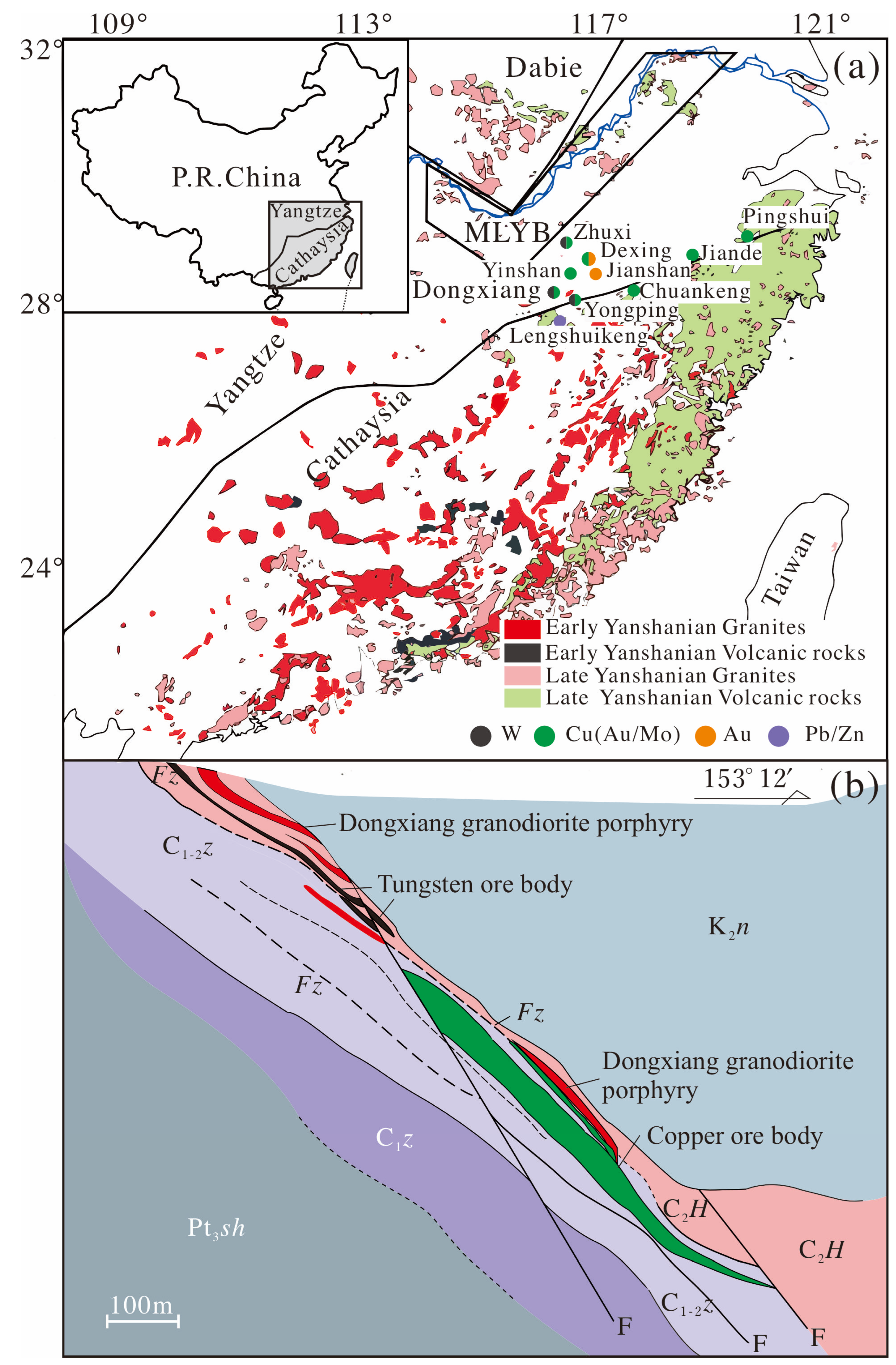
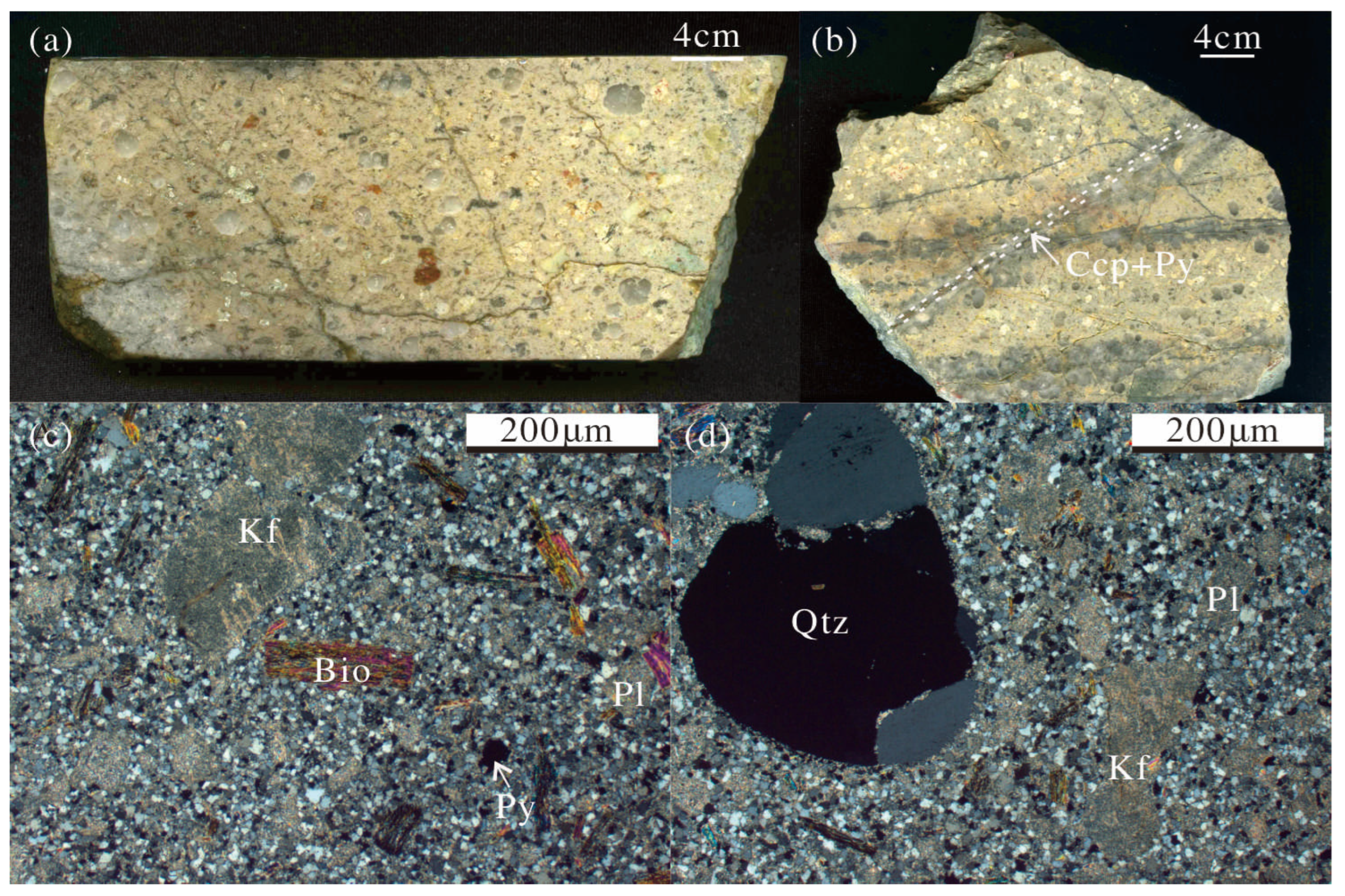

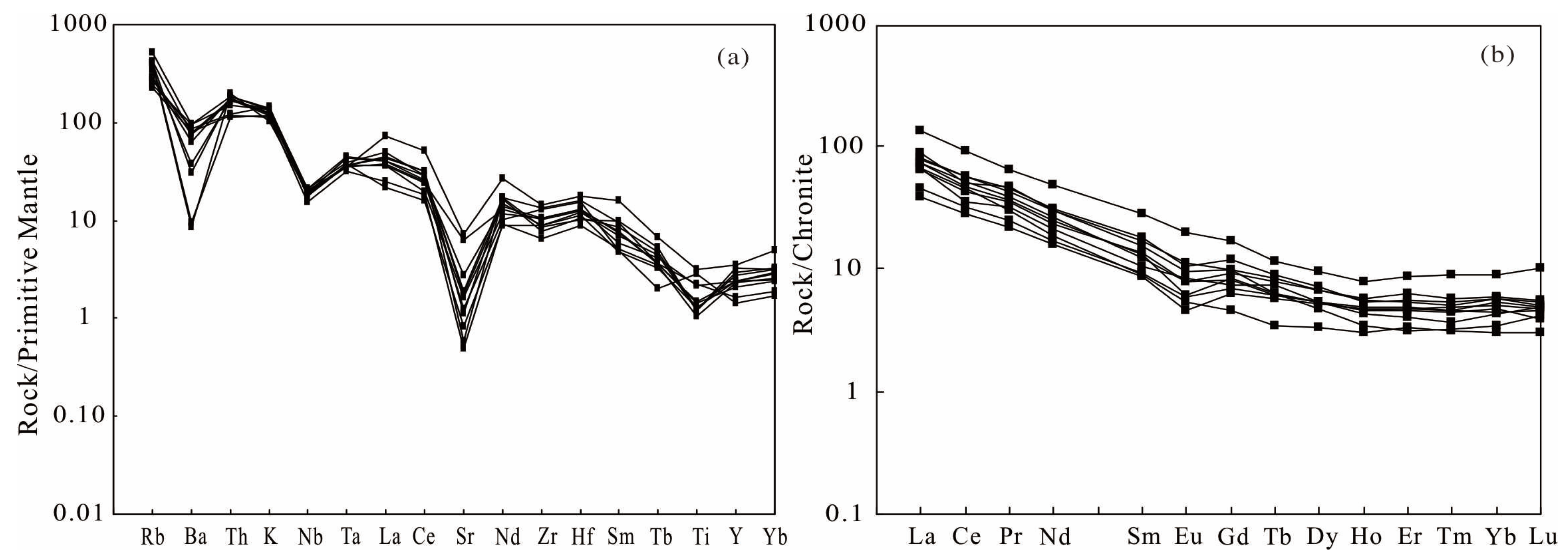
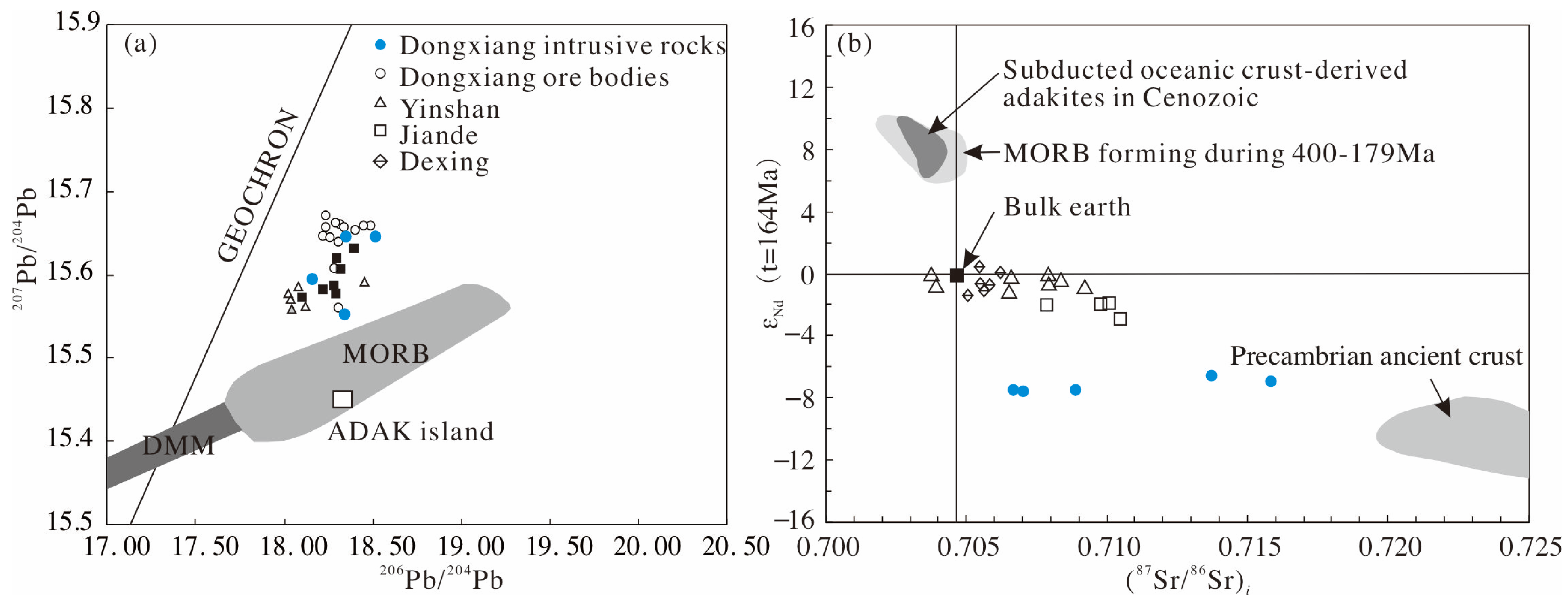
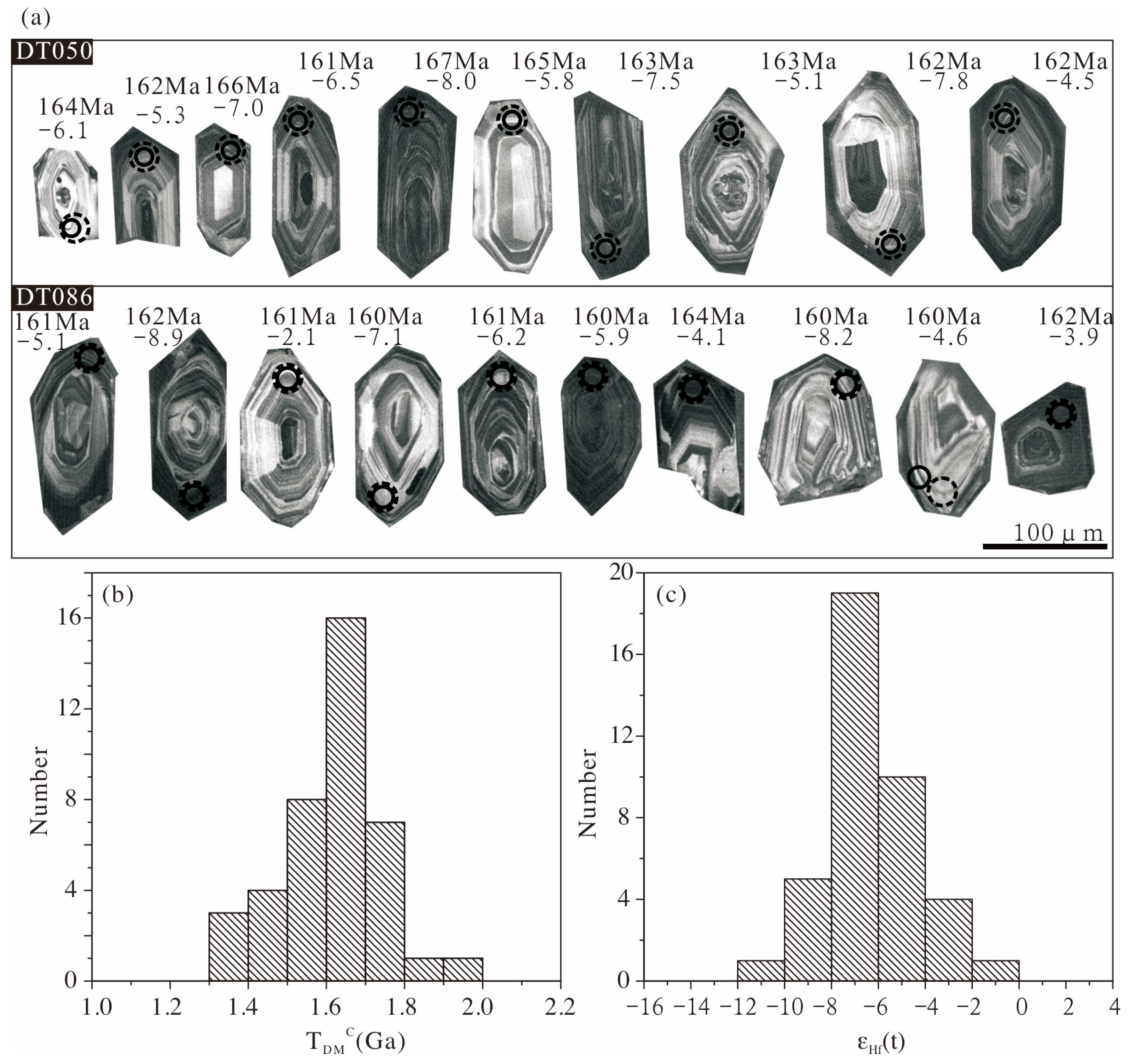
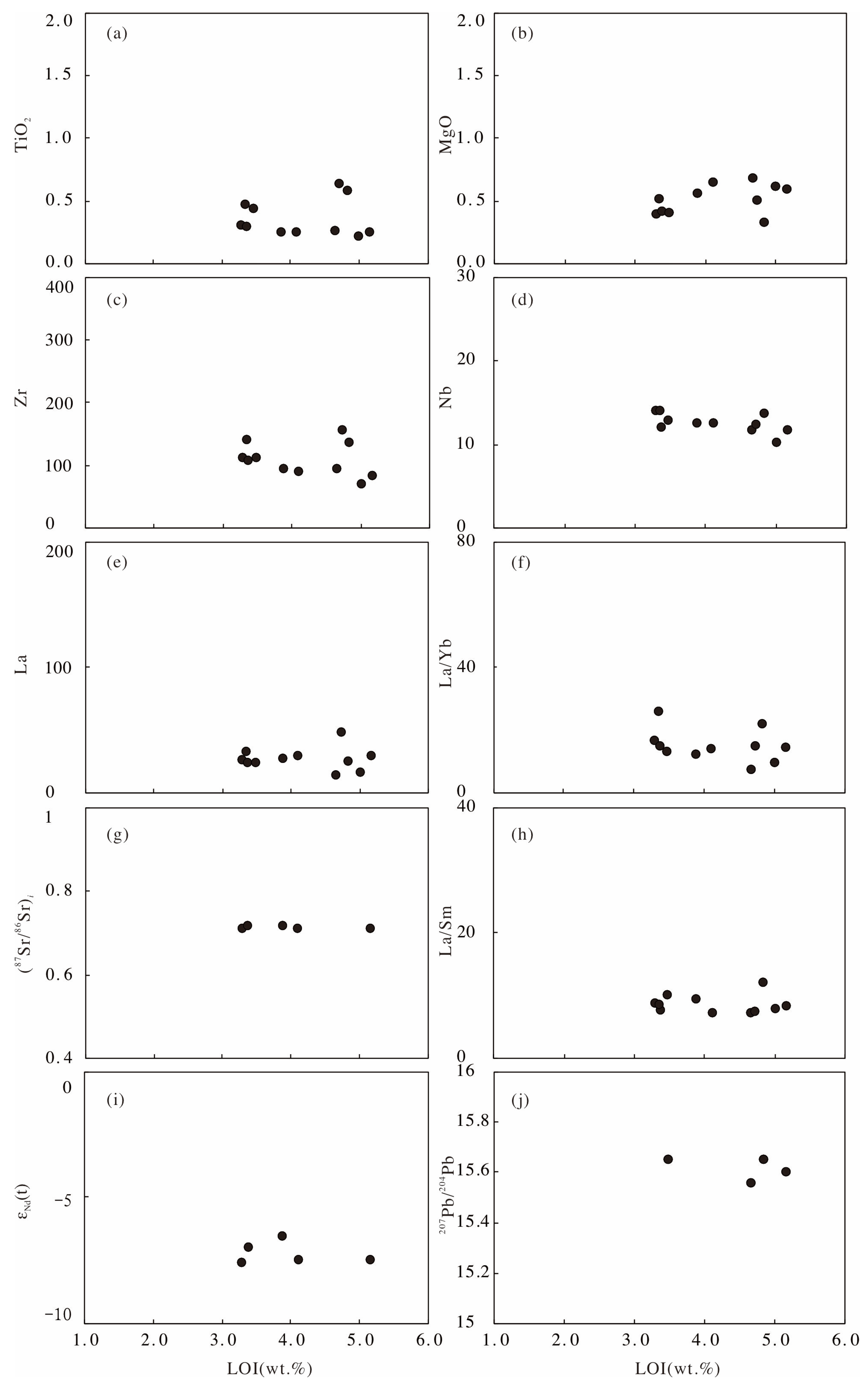
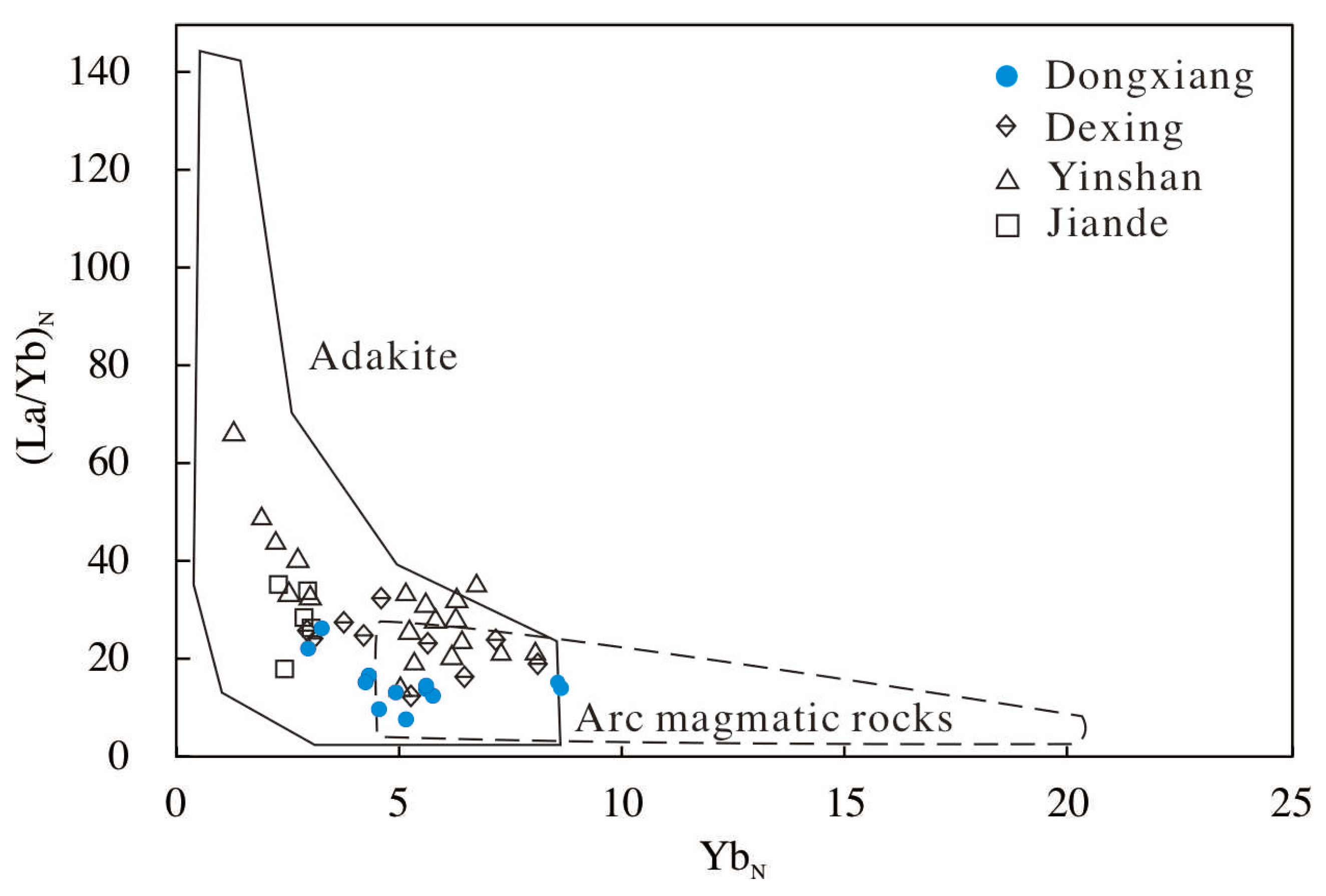


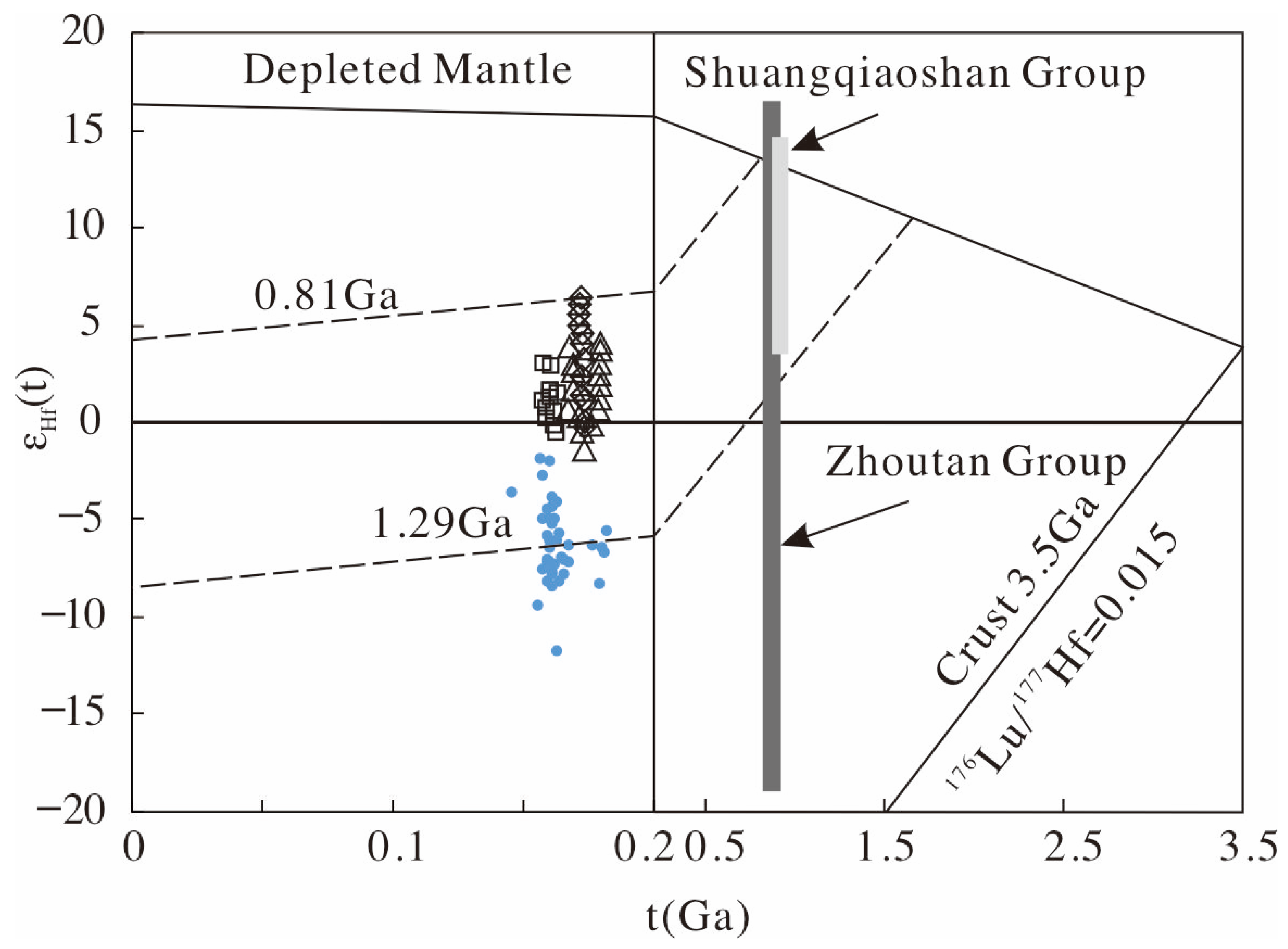
| Sample | DT028 | DT030 | DT050 | DT051 | DT053 | DT056 | DT057 | DT082 | DT084 | DT086 | DT088 |
|---|---|---|---|---|---|---|---|---|---|---|---|
| Major elements (wt.%) | |||||||||||
| Al2O3 | 10.97 | 10.15 | 14.20 | 12.33 | 13.47 | 12.34 | 13.28 | 18.37 | 14.74 | 16.33 | 18.53 |
| CaO | 0.13 | 0.04 | 0.16 | 0.09 | 0.25 | 0.06 | 0.05 | 0.36 | 0.27 | 0.32 | 0.35 |
| Fe2O3 | 2.00 | 2.96 | 1.01 | 2.20 | 1.03 | 3.16 | 2.57 | 1.12 | 1.34 | 0.71 | 5.86 |
| FeO | 1.80 | 2.67 | 0.91 | 1.98 | 0.93 | 2.85 | 2.31 | 1.01 | 1.21 | 0.64 | 5.28 |
| TFe2O3 | 4.00 | 5.93 | 2.03 | 4.41 | 2.07 | 6.33 | 5.14 | 2.25 | 2.69 | 1.42 | 11.73 |
| K2O | 3.55 | 3.31 | 4.06 | 3.90 | 3.65 | 3.88 | 4.28 | 3.42 | 3.48 | 3.97 | 2.95 |
| MgO | 0.64 | 0.61 | 0.39 | 0.55 | 0.41 | 0.59 | 0.67 | 0.32 | 0.40 | 0.51 | 0.50 |
| Na2O | 0.02 | 0.04 | 0.01 | 0.05 | 0.04 | 0.04 | 0.05 | 0.00 | 0.01 | 0.11 | 0.09 |
| P2O5 | 0.09 | 0.03 | 0.09 | 0.06 | 0.15 | 0.05 | 0.05 | 0.18 | 0.13 | 0.16 | 0.19 |
| SiO2 | 76.30 | 74.74 | 75.16 | 74.46 | 76.55 | 71.11 | 71.56 | 69.38 | 74.55 | 73.50 | 60.00 |
| TiO2 | 0.24 | 0.21 | 0.30 | 0.24 | 0.29 | 0.25 | 0.26 | 0.58 | 0.43 | 0.46 | 0.63 |
| LOI | 4.12 | 5.02 | 3.31 | 3.90 | 3.39 | 5.18 | 4.68 | 4.85 | 3.49 | 3.36 | 4.74 |
| Total | 99.86 | 99.78 | 99.62 | 99.77 | 100.18 | 99.51 | 99.77 | 99.61 | 100.07 | 100.08 | 99.12 |
| Trace elements (ppm) | |||||||||||
| Ti | 1463.87 | 1186.44 | 1619.81 | 1290.93 | 1490.69 | 1388.75 | 1459.59 | 3161.81 | 2732.81 | 2848.40 | 3546.81 |
| V | 40.77 | 49.62 | 38.01 | 46.72 | 37.06 | 39.24 | 46.83 | 87.41 | 85.63 | 85.22 | 292.93 |
| Cr | 6.56 | 8.02 | 8.72 | 4.86 | 8.34 | 9.80 | 7.86 | 55.12 | 33.18 | 26.85 | 304.86 |
| Mn | 19.84 | 15.36 | 58.54 | 31.43 | 59.83 | 15.98 | 103.17 | 41.86 | 60.61 | 61.86 | 27.32 |
| Co | 12.66 | 25.92 | 3.46 | 21.58 | 5.23 | 12.61 | 14.42 | 7.24 | 2.14 | 0.84 | 0.91 |
| Cu | 7.62 | 18.06 | 25.85 | 111.27 | 80.23 | 15.39 | 12.43 | 8.28 | 4.91 | 4.56 | 83.27 |
| Zn | 12.58 | 22.51 | 7.28 | 20.99 | 22.02 | 18.44 | 18.95 | 28.41 | 85.14 | 68.78 | 79.42 |
| Ga | 13.59 | 14.33 | 15.00 | 14.95 | 14.64 | 14.69 | 16.10 | 15.66 | 18.34 | 18.86 | 128.30 |
| Rb | 171.51 | 135.08 | 245.61 | 172.57 | 203.77 | 146.98 | 161.91 | 244.55 | 257.61 | 307.99 | 237.47 |
| Sr | 22.54 | 9.94 | 54.84 | 34.67 | 123.60 | 11.64 | 16.48 | 24.89 | 32.16 | 37.72 | 145.33 |
| Y | 13.84 | 10.03 | 10.36 | 12.59 | 9.11 | 11.86 | 10.30 | 6.13 | 10.35 | 7.00 | 14.83 |
| Zr | 89.60 | 69.54 | 110.09 | 92.73 | 105.83 | 82.19 | 92.02 | 135.71 | 111.48 | 139.15 | 153.74 |
| Nb | 12.45 | 10.17 | 13.96 | 12.35 | 11.94 | 11.57 | 11.66 | 13.58 | 12.78 | 13.88 | 12.32 |
| Mo | 63.99 | 2.64 | 4.02 | 2.81 | 2.23 | 5.34 | 14.15 | 4.48 | 5.86 | 3.39 | 8.91 |
| Sn | 10.52 | 12.42 | 3.15 | 10.42 | 3.49 | 10.82 | 10.78 | 2.93 | 3.58 | 2.82 | 17.75 |
| Cs | 13.24 | 7.35 | 34.47 | 10.41 | 34.55 | 10.60 | 5.13 | 40.29 | 39.02 | 52.29 | 46.88 |
| Ba | 422.32 | 526.58 | 206.02 | 493.58 | 248.74 | 643.27 | 572.12 | 62.64 | 517.82 | 643.46 | 57.51 |
| La | 28.41 | 16.15 | 26.07 | 26.26 | 23.39 | 29.23 | 13.97 | 24.12 | 23.70 | 31.78 | 47.47 |
| Ce | 53.48 | 30.20 | 44.04 | 48.25 | 40.34 | 52.62 | 26.55 | 41.91 | 33.02 | 47.54 | 85.54 |
| Pr | 6.11 | 3.32 | 4.88 | 5.15 | 4.72 | 5.70 | 2.93 | 3.98 | 4.24 | 6.39 | 8.60 |
| Nd | 21.72 | 11.69 | 17.46 | 18.72 | 16.03 | 20.88 | 11.03 | 12.96 | 14.62 | 21.12 | 33.48 |
| Sm | 4.03 | 2.10 | 3.01 | 2.82 | 3.11 | 3.52 | 1.95 | 2.01 | 2.37 | 3.81 | 6.38 |
| Eu | 0.91 | 0.50 | 0.63 | 0.53 | 0.67 | 0.83 | 0.40 | 0.46 | 0.72 | 0.95 | 1.68 |
| Gd | 3.58 | 2.12 | 2.57 | 2.75 | 2.48 | 2.96 | 1.89 | 1.39 | 2.25 | 2.96 | 5.04 |
| Tb | 0.52 | 0.35 | 0.36 | 0.45 | 0.35 | 0.47 | 0.33 | 0.20 | 0.42 | 0.36 | 0.66 |
| Dy | 2.71 | 2.00 | 2.01 | 2.53 | 2.00 | 2.52 | 1.96 | 1.25 | 2.01 | 1.76 | 3.59 |
| Ho | 0.45 | 0.39 | 0.41 | 0.48 | 0.36 | 0.46 | 0.40 | 0.25 | 0.39 | 0.29 | 0.66 |
| Er | 1.37 | 1.11 | 1.21 | 1.56 | 0.98 | 1.33 | 1.17 | 0.83 | 1.15 | 0.77 | 2.11 |
| Tm | 0.19 | 0.15 | 0.16 | 0.20 | 0.13 | 0.18 | 0.16 | 0.11 | 0.17 | 0.11 | 0.31 |
| Yb | 1.40 | 1.15 | 1.09 | 1.45 | 1.06 | 1.40 | 1.31 | 0.75 | 1.24 | 0.84 | 2.19 |
| Lu | 0.20 | 0.15 | 0.17 | 0.21 | 0.18 | 0.19 | 0.19 | 0.11 | 0.18 | 0.16 | 0.39 |
| Hf | 2.93 | 2.54 | 3.71 | 3.39 | 3.53 | 2.95 | 3.16 | 4.41 | 3.69 | 4.45 | 5.02 |
| Ta | 1.34 | 1.17 | 1.68 | 1.59 | 1.37 | 1.36 | 1.39 | 1.30 | 1.35 | 1.43 | 1.32 |
| Th | 14.26 | 9.34 | 14.49 | 13.09 | 13.80 | 11.82 | 9.66 | 9.14 | 13.71 | 14.70 | 15.65 |
| U | 3.61 | 2.55 | 4.37 | 2.46 | 3.33 | 3.36 | 3.36 | 3.57 | 2.88 | 4.78 | 17.63 |
| (La/Yb)N | 13.68 | 9.52 | 16.21 | 12.21 | 14.85 | 14.07 | 7.23 | 21.70 | 12.92 | 25.70 | 14.67 |
| ∑REE | 125.08 | 71.38 | 104.07 | 111.36 | 95.83 | 122.30 | 64.24 | 90.35 | 86.47 | 118.84 | 198.10 |
| DT028 | DT050 | DT051 | DT053 | DT056 | |
|---|---|---|---|---|---|
| 87Rb/86Sr | 22.125863 | 12.993669 | 14.453388 | 4.778184 | 36.839156 |
| 87Sr/86Sr | 0.760611 | 0.737420 | 0.747496 | 0.727036 | 0.792723 |
| 2σ | 0.000007 | 0.000006 | 0.000006 | 0.000006 | 0.000006 |
| (87Sr/86Sr)i | 0.708930 | 0.707070 | 0.713736 | 0.715875 | 0.706675 |
| 147Sm/144Nd | 0.113000 | 0.105000 | 0.091800 | 0.118000 | 0.103000 |
| 143Nd/144Nd | 0.512166 | 0.512152 | 0.512186 | 0.512193 | 0.512154 |
| 2σ | 0.000003 | 0.000005 | 0.000003 | 0.000003 | 0.000005 |
| (143Nd/144Nd)i | 0.512045 | 0.512039 | 0.512087 | 0.512066 | 0.512044 |
| εNd(t) | −7.50 | −7.60 | −6.60 | −7.00 | −7.50 |
| TDMC(Ga) | 1.68 | 1.67 | 1.57 | 1.66 | 1.66 |
| TDM(Ga) | 1.49 | 1.40 | 1.21 | 1.53 | 1.37 |
Disclaimer/Publisher’s Note: The statements, opinions and data contained in all publications are solely those of the individual author(s) and contributor(s) and not of MDPI and/or the editor(s). MDPI and/or the editor(s) disclaim responsibility for any injury to people or property resulting from any ideas, methods, instructions or products referred to in the content. |
© 2023 by the authors. Licensee MDPI, Basel, Switzerland. This article is an open access article distributed under the terms and conditions of the Creative Commons Attribution (CC BY) license (https://creativecommons.org/licenses/by/4.0/).
Share and Cite
Cai, Y.; Ni, P.; Wang, G.; Chen, H. Geochemical Characteristics of the Granodiorite Porphyry in Dongxiang W-Cu Deposit, SE China. Minerals 2023, 13, 380. https://doi.org/10.3390/min13030380
Cai Y, Ni P, Wang G, Chen H. Geochemical Characteristics of the Granodiorite Porphyry in Dongxiang W-Cu Deposit, SE China. Minerals. 2023; 13(3):380. https://doi.org/10.3390/min13030380
Chicago/Turabian StyleCai, Yitao, Pei Ni, Guoguang Wang, and Hui Chen. 2023. "Geochemical Characteristics of the Granodiorite Porphyry in Dongxiang W-Cu Deposit, SE China" Minerals 13, no. 3: 380. https://doi.org/10.3390/min13030380
APA StyleCai, Y., Ni, P., Wang, G., & Chen, H. (2023). Geochemical Characteristics of the Granodiorite Porphyry in Dongxiang W-Cu Deposit, SE China. Minerals, 13(3), 380. https://doi.org/10.3390/min13030380







